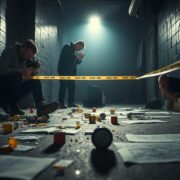by Jason Fries, CEO of 3D Forensic, and Sean Daly, Director of Public Relations, 3D Forensic
Court cases have always relied on visual aids to break down complex incidents. This once entailed using hand-drawn illustrations or photographs to communicate key aspects of a case. This was the standard throughout most of the 20th century until computers streamlined the litigation process. Storing, sharing, and communicating case material became instant and cleaner with this innovation.
As computer and visual technology advanced, the potential for forensic visualization grew through animation. Today, it is common for accidents and critical incidents to be demonstrated through digital animation so audiences can clearly see the critical factors of incidents. Through years of legal and technological refinement, animation has become the standard in modern forensic visualization.
Early years
Forensic animation first took shape in the American court system in 1988 with the tragic Delta 191 plane crash in Dallas, TX. This crash killed 137 people and occurred because the flight crew was unaware of severe weather near the runway. The trial for this case would become the longest major aviation trial in US history, taking 14 months to litigate.
Z-Axis, a Colorado-based firm, was recruited by the Department of Justice to demonstrate the path of the plane as well as the forces acting upon it. The production itself took two years to complete and cost about $250,000. Compared to modern 3D animations, this animation was very simple but laid the groundwork for demonstrating complex issues to an audience of lay people.
The second notable admission of courtroom animation was the criminal case of Jim Mitchell’s homicide of his brother Artie in 1991 in Corte Madera, CA. This production became the first animation to be used in a criminal trial in the United States. Prosecutors worked with Alexander Jason of ANITE Group to produce an animation of the shooting based on ballistics and a 911 phone call from Artie’s girlfriend at the time. Despite questions about the production’s assertions of timing, this animation blazed a path for modern ballistic and shooting visualizations.
Another case, in which the third forensic animation was admitted into the American trial system, was tried in 1992 to demonstrate the story behind the death of six-year-old Nicole Rae Walker. This case tried Kenneth Pierce, the drunk driver of a Chevrolet Silverado that hit three people one night in Dania, Florida. Evidence Evidence is any form of proof, such as objects, materials, or scientific findings, presented to establish or disprove a fact in a legal proceeding. It is used to reconstruct events and link or exclude individuals Read Full Definition of his car’s damage, the victim’s bodily markings, and Pierce’s neighbor’s testimony led investigators to name him as the prime suspect.
Evidence is any form of proof, such as objects, materials, or scientific findings, presented to establish or disprove a fact in a legal proceeding. It is used to reconstruct events and link or exclude individuals Read Full Definition of his car’s damage, the victim’s bodily markings, and Pierce’s neighbor’s testimony led investigators to name him as the prime suspect.
Prosecutors chose to take extra steps to demonstrate the path he took for the jury. The to-scale animation produced for this case showed how Mr. Pierce’s vehicle veered off the road and into the group, hitting Ms. Walker, before driving off. This exhibit demonstrated gross negligence on Mr. Pierce’s part and led to a conviction of vehicular homicide.
Each of these animations demonstrated unique incidents, foreshadowing the range of usefulness for this new tool. While very expensive and time consuming at the time, the impending increase in technological capabilities and forensic specialization would make this technology much more accessible
Increased Adoption
The first rudimentary forensic animations of the 80’s were developed by engineers and forensic specialists who hadn’t specialized in visual animation. Soon into the 90’s, however, visual presentations accounted for 50% of some engineering companies’ profits.
The trend became more affordable as firms started to produce more videos. Attorneys were also enamored by these productions, scrambling to retain animators or react when facing them in trial.
The main issue forensic animations faced in early adoption was admissibility and concerns of accuracyIn scientific and measurement contexts, "accuracy" refers to the degree of proximity or closeness between a measured value and the true or actual value of the measured quantity. Accuracy indicates how well a measurement reflects Read Full Definition. Courts across America began to adopt standards for admissibility, leading to standardization and a focus on accuracy.
Technological Advancements
Several technological advancements since the first forensic animations have improved the timeliness, affordability, and accuracy of these productions.
Computer Processing Power
In 1970, Intel co-founder Gordon E. Moore declared that computer processing power would double every two years, and so far, has been proven mostly correct. Following this trend, computers used by experts to produce forensic animations have shortened production from about two years to about eight to ten weeks. For experienced teams, the most time-intensive aspect of developing a forensic animation now involves expert collaboration and data Information in analog or digital form that can be transmitted or processed. Read Full Definition integration, and not visual development.
Information in analog or digital form that can be transmitted or processed. Read Full Definition integration, and not visual development.
3D Laser Scanning
One of the greatest innovations in forensic production is the adoption of the 3D laser scanner.
Laser scanners are devices that measure millions of measurement points within a nearby range to create accurate point-cloud maps. These devices have revolutionized the accurate visualization of crime/accident scenes, vehicles, and people by performing complete scans within a matter of minutes
This tech was first admitted for trial visualizations in an accident reconstruction"Accident reconstruction" refers to the process of using physical evidence, scientific principles, and investigative techniques to create a theoretical model or reenactment of a specific crime or accident scene. This method is employed to understand Read Full Definition video by Precision Simulations in the case of State of Hawaii v. Arakawa in 2001. This case involved a fatal accident between a drunk driver and young lady in Hawaii. Laser scanners were utilized to digitally capture the site of the accident, simplifying the development of the reconstruction’s scene
Once this exhibit was admitted, it became the first laser-scan based visualization admitted to trial in the American court system, and would inspire visualization firms in the future to follow suit.
Photo/Video Drones
Camera drones have become widely available to professionals and consumers in the 2010’s. With increasingly powerful camera technology, these drones have made capturing crime/accident scenes much easier and efficient than handheld cameras.
Overhead shots taken by drones are often used often as contextual maps to demonstrate events that occurred over a large distance. They can also efficiently capture videos of large areas, which can then be plugged into point-cloud software to create useful 3D models.
Today, forensic animations have become the primary method of demonstrating complex legal narratives. Once quoted as “the most significant courtroom innovation since photography,” forensic animation has captivated juries and judges for over 40 years.
The practice has justifiably faced unique scrutiny across the United States, and because of this scrutiny, standards ensure that the theme of these productions is education and not glamorization. It has proven undoubtedly useful in capturing an audience’s attention and effectively conveying complexities of forensic events, making it a key tool to attorneys or investigators working on crime or accident cases.
About the Author:
Jason Fries is a multi-disciplined forensic expert and serves as CEO and Lead Expert at 3D Forensic, Inc. He has produced forensic analyses and animations for civil and criminal cases since 1998. Fries has produced and directed thousands of forensic animations and has worked with leading academics to help develop advanced analytical procedures in the fields of nighttime visibility and officer-involved shootings. Sean Daly serves as Director of Public Relations at 3D Forensic, Inc. Daly plays a key role in educating audiences on the modern forensic industry








